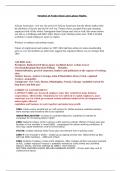Timeline of Trade Union and Labour Rights
African Americans- civil war. the arrival of African Americans into the labour market after
the abolition of slavery and end of civil war. Former slaves accepted lower pay meaning
employers laid off the whites. Immigrants from Europe and Asia as well; this meant unions
saw this as a challenge and didn’t allow them to join, limiting union sizes. With a divided
workforce it made employers easier to exploit
Workers in southern and northern states:
Nature of employment and workers in 1865: little had been achieved, union membership
grew to over 2m members,no other facts suggest that organised labour was no stronger than
1865
GILDED AGE:
Presidents: Rutherford B Hayes,James Garfield,Chester Arthur,Grover
Cleveland,Benjamin Harrison,William Mckinley
Industrialisation, greed of corporate, bankers and politicians-at the expense of working
class
Robber barons- Andrew Carnegie, John D Rockefeller, Henry Frick- exploited
workers- monopolies
Immigrants- New York, Boston, Philadelphia, St louis, Chicago- unskilled worked for
long hours and little pay-
AMERICAN GOVERNMENT:
LAISSEZ FAIRE: gov favoured employer since they could form large business
corporations. Allowed this. Manufactures were allowed to exploit employees, most
consistent ways in which government actions/attitudes hindered the development of
union rights, allowed.
capitalism and business to work together and make large profit.
1865- trade unions existed but as craft unions for skilled workers unskilled workers
were exempt and therefore left to be exploited
INDUSTRIALISATION- increase in unskilled labourers, exploited so started to
campaign for increasing labour rights!
1866- National Labour Union (various crafts workers united)- William H Sylvis was also
founder of iron moulder’s union(1860) - campaigned for better working conditions, 8
hour day, equal treatment, end to forced labour
SYLVIS: created national strike fund upon recruitment free of joining union
1866-7- Iron Founder’s Strike – ended up accepting normal rate failed strike by NLU
still had 300k members – 1869 end of NLU
1869- Knights of Labour- Uriah smith stephens. After collapse of NLU everyone resorted
to KOL. Leader replaced Terence v powderly wanted to unite skilled and unskilled
labours, blacks, womens suffrage by 1880’s. more diverse.
DOCTORS,LAWYERS,LIQUOR SELLERS,GAMBLERS EXEMPT – 8 hour work day, end to
child/convict labour
, BOMBING OF HAYMARKET SQUARE: started of as general strike- may 1st 1886- bomb
went off ,wave of arrests- demise of KOL – fled to AFL
1869- National Negro Labour Union – due to discrimination (adverse impact on
solidarity and power)encouraged to make own
1873- Wall Street Crash - slump in economy had a positive effect on trade unions as
rise in unemployment and poorer wages so they could use the context to their
advantage
1886- Wabash southwest Railroad Strike - no agreement reached
1886- American Federation of Labour- labour movement viewed very negatively,
extremists cop killers. PRO AMERICAN ASSOCIATION OF CRAFT UNIONS (certain skill)
skilled white men to make it more ‘effective’ who are seen to be negatively effecting
unions
- ‘Bread and butter’ unionism – higher wages, less hours, better working conditions
that’s it!
- 8-hour day for work, sleep, then what we will
- Human nature propaganda- Samuel embracing human nature, do not want
to overthrow the system just want a little more
- First mainstream American labour movement- not marginalized anymore
and can influence labour politics.
1886- Haymarket Affair – mass meeting in Haymarket square, police tried shutdown,
bomb, 7 police dead, lack of evidence,8 arrested,4 executed, 1887. Downfall of KOL.
NEGATIVE IMPACT
lead to immigration – limited progress of trade union and labour workers- as they were
desperate and took low pay long hours and deprived conditions.
immigrant labourers- molly Maguire’s 1873 Irish mining – violence! Justifiable and
inevitable due to poor conditions faced.
1890- Sherman Anti-Trust Act ‘laissez faire’ economy allowed employer to rise to power
and were able to sack and cut wages down without federal intervention. signed by
Benjamin Harrison
- During industrial age, hands off approach, rapid growth of corps and
industrialisation – however, subsidies given therefore can be argued.
- Trusts – 1870’s monopolies called trusts using power to crush competition,
unfair. Anti competitive prices
- Passed – that trusts are said to be illegal! - President Harrison.
- For a decade, was used against unions (unions illegal combo of orgs
interfering with trade) therefore, they are guilty)
- Teddy Roosevelt trust bust - regressive republican – northern security co.
vs us – reversed president
- People opposed due to natural
1892- Homestead Strike – failure between the carneige steel company in homestead
and the amalgamated associaton of iron and steel workers exploded into violence. This
was due to a three year contract with the company coming to an end and frick
announced pay cuts for hundreds of workers. He refused to negotiate and tried to shut
them out. Pinkerton detectives called (known for infiltrating unions). Gunfire let off.
Union surrendered Some 12 people were killed. AA collapsed and several members
arrested. All steel plants became non-unionised in Pennsylvania WEAKEND WORKERS
RIGHTS
1894- Pullman Strike – George pullman also made sleeper car- millionaire. Town named
after himself, so he can control workers, exploit workers. ‘panic of 1893’ wasn’t making
as much therefore he decided to cut down wages at pullman paris car company- low




